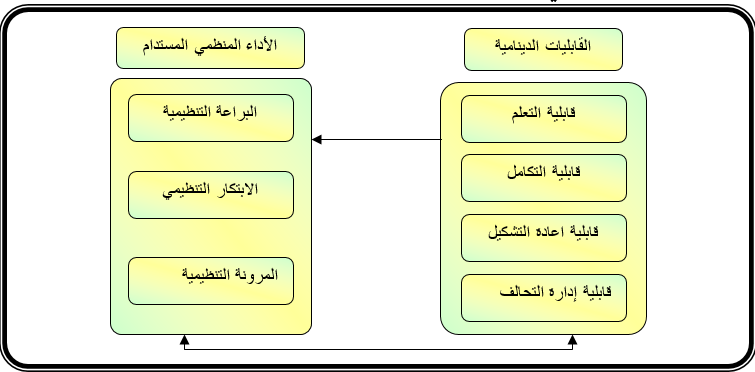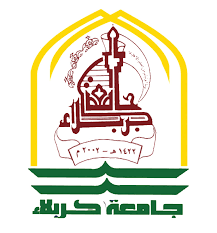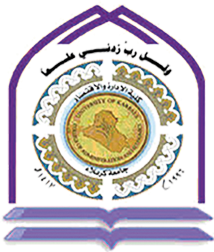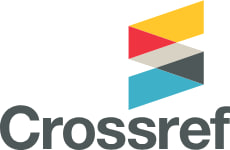The Impact of Dynamic Capabilities on Achieving Sustainable Organizational Performance.
An Analytical Study of the Opinions of University of Kufa Professors
Keywords:
Dynamic Capabilities, Sustainable Organizational PerformanceAbstract
Purpose: This study aims to study and determine the nature of the relationship between dynamic capabilities as an explanatory variable And sustainable organizational performance as a responsive variable.
Methodology / Design: 135 questionnaires were distributed to professors at the University of Kufa who hold the title of Professor in all faculties of the university (21), and the retrieved questionnaires (129) were (127) valid for statistical analysis, (SPSS) as well as AMOS.
Theoretical results: A knowledge gap on the interpretation of the relationship between the variables of research in addition to the researchers' quest to demonstrate the importance of sustainable organizational performance as an important means to achieve the high competitiveness of the organizations currently.
Results: The research results in a set of results, including a direct significant effect between dynamic capabilities and sustainable organizational performance.
Scientific results: The results of the research can be used as the organizations' interest and developing dynamic capabilities will lead to achieving sustainable performance and achieving its future goals.
Originality / Value: The research came to fill a knowledge gap, which was the result of an earlier research that discusses the two research variables in one research model and the impact of this relationship on enhancing the social and competitive position of the organization.
References
Akrivou, K., & Bradbury-Huang, H. (2011). Executive catalysts: Predicting sustainable organizational performance amid complex demands. The Leadership Quarterly, 22(5), 995-1009.
Ambrosini, V., Bowman, C., & Collier, N. (2009). Dynamic capabilities: an exploration of how firms renew their resource base. British Journal of Management, 20(s1).
Anastassiu, M., Santoro, F. M., Recker, J., & Rosemann, M. (2016). The quest for organizational flexibility: driving changes in business processes through the identification of relevant context. Business Process Management Journal, 22(4), 763-790.
Andriopoulos, C., & Lewis, M. W. (2009). Exploitation-exploration tensions and organizational ambidexterity: Managing paradoxes of innovation. Organization Science, 20(4), 696-717.
Ann Rowland, C., & David Hall, R. (2013). Perceived unfairness in appraisal: engagement and sustainable organizational performance. EuroMed Journal of Business, 8(3), 195-208.
Barney, J. (1991). Firm resources and sustained competitive advantage. Journal of management, 17(1), 99-120.
Barrales-Molina, V., Montes, F. J. L., & Gutierrez-Gutierrez, L. J. (2015). Dynamic capabilities, human resources and operating routines: a new product development approach. Industrial Management & Data Systems, 115(8), 1388-1411.
Baškarada, S., Watson, J., & Cromarty, J. (2016). Leadership and organizational ambidexterity. Journal of Management Development, 35(6), 778-788.
Battisti, G., & Stoneman, P. (2010). How innovative are UK firms? Evidence from the fourth UK community innovation survey on synergies between technological and organizational innovations. British Journal of Management, 21(1), 187-206.
Beske, P. (2012). Dynamic capabilities and sustainable supply chain management. International Journal of Physical Distribution & Logistics Management, 42(4), 372-387.
Brekalo, L., Albers, S., & Delfmann, W. (2013). Logistics alliance management capabilities: where are they?. International Journal of Physical Distribution & Logistics Management, 43(7), 529-543.
Breznik, L., & D. Hisrich, R. (2014). Dynamic capabilities vs. innovation capability: are they related?. Journal of small business and enterprise development, 21(3), 368-384.
Brühl, R., Horch, N., & Osann, M. (2010). Improving integration capabilities with management control. European Journal of Innovation Management, 13(4), 385-408.
Camisón, C., & Villar-López, A. (2014). Organizational innovation as an enabler of technological innovation capabilities and firm performance. Journal of business research, 67(1), 2891-2902.
Cavusgil, E., Seggie, S. H., & Talay, M. B. (2007). Dynamic capabilities view: Foundations and research agenda. Journal of marketing theory and practice, 15(2), 159-166.
Collis, D. J., & Montgomery, C. A. (2008). Competing on resources. Harvard business review.
Dangol, R., & Kos, A. (2014). Knightian uncertainty and risk: A basis for untangling dynamic capabilities from operational capabilities. Journal of Strategy and Management, 7(4), 337-353.
Easterby-Smith, M., Lyles, M. and Peteraf, M.A. (2009), “Dynamic capabilities: current debates and future directions”, British Journal of Management, Vol. 20 No. 1, pp. 1-8.
Eisenhardt, K. M., & Martin, J. A. (2000). Dynamic capabilities: what are they?. Strategic management journal, 1105-1121.
Englehardt, C. S., & Simmons, P. R. (2002). Organizational flexibility for a changing world. Leadership & Organization Development Journal, 23(3), 113-121.
Eriksson, T. (2013). Methodological issues in dynamic capabilities research–a critical review. Baltic Journal of Management, 8(3), 306-327.
Fay, D., Shipton, H., West, M. A., & Patterson, M. (2015). Teamwork and organizational innovation: The moderating role of the HRM context. Creativity and Innovation Management, 24(2), 261-277.
Fu, N., Flood, P. C., Bosak, J., Morris, T., & O'Regan, P. (2015). How do high performance work systems influence organizational innovation in professional service firms?. Employee Relations, 37(2), 209-231.
Gadenne, D., Mia, L., Sands, J., Winata, L., & Hooi, G. (2012). The influence of sustainability performance management practices on organisational sustainability performance. Journal of Accounting & Organizational Change, 8(2), 210-235.
Geerts, A., Blindenbach-Driessen, F., & Gemmel, P. (2010). Ambidextrous innovation behaviour in service firms. Vlerick Leuven Gent Management School, Ghent.[Google Scholar].
Gowen, C. R., & Tallon, W. J. (2005). Effect of technological intensity on the relationships among Six Sigma design, electronic-business, and competitive advantage: A dynamic capabilities model study. The journal of high technology management research, 16(1), 59-87.
Grant, R. M. (1996). Prospering in dynamically-competitive environments: Organizational capability as knowledge integration. Organization science, 7(4), 375-387.
Gupta, A. K., Smith, K. G., & Shalley, C. E. (2006). The interplay between exploration and exploitation. Academy of management journal, 49(4), 693-706.
Hamid Hawass, H. (2010). Exploring the determinants of the reconfiguration capability: a dynamic capability perspective. European Journal of Innovation Management, 13(4), 409-438.
Haner, U. E. (2016, December). Organizational innovation-A matter of concurrency. In ISPIM Innovation Symposium (p. 1). The International Society for Professional Innovation Management (ISPIM).
Hatum, A., & Pettigrew, A. M. (2004). Adaptive responses under competitive pressure: organizational flexibility in an emergent economy. Management Research: Journal of the Iberoamerican Academy of Management, 2(2), 97-114.
Helfat, C. E., & Winter, S. G. (2011). Untangling dynamic and operational capabilities: Strategy for the (N) ever‐changing world. Strategic management journal, 32(11), 1243-1250.
Hosseini, S., Hosseini, S., Kees, A., Kees, A., Manderscheid, J., Manderscheid, J., ... & Rosemann, M. (2017). What does it take to implement open innovation? Towards an integrated capability framework. Business Process Management Journal, 23(1), 87-107.
Ingelgård, A., Roth, J., Styhre, A., & Shani, A. B. (2002). Dynamic learning capability and actionable knowledge creation: clinical R&D in a pharmaceutical company. The Learning Organization, 9(2), 65-77.
J. Gorgievski, M., Antonio Moriano, J., & B. Bakker, A. (2014). Relating work engagement and workaholism to entrepreneurial performance. Journal of Managerial Psychology, 29(2), 106-121.
Jansen, J. J., George, G., Van den Bosch, F. A., & Volberda, H. W. (2008). Senior team attributes and organizational ambidexterity: The moderating role of transformational leadership. Journal of Management Studies, 45(5), 982-1007.
Jurksiene, L., & Pundziene, A. (2016). The relationship between dynamic capabilities and firm competitive advantage: The mediating role of organizational ambidexterity. European Business Review, 28(4), 431-448.
Kuo, S. Y., Lin, P. C., & Lu, C. S. (2017). The effects of dynamic capabilities, service capabilities, competitive advantage, and organizational performance in container shipping. Transportation Research Part A: Policy and Practice, 95, 356-371.
Kuuluvainen, A. (2012). How to concretize dynamic capabilities? Theory and examples. Journal of Strategy and management, 5(4), 381-392.
Lal, P., & Bharadwaj, S. S. (2016). Understanding the impact of cloud-based services adoption on organizational flexibility: An exploratory study. Journal of Enterprise Information Management, 29(4), 566-588.
Lee, P. Y., Wu, M. L., Kuo, C. C., & Li, C. S. J. (2016). How to deploy multiunit organizations’ dynamic capabilities?. Management Decision, 54(4), 965-980.
Li, C. R. (2013). How top management team diversity fosters organizational ambidexterity: The role of social capital among top executives. Journal of Organizational Change Management, 26(5), 874-896.
Li, D. Y., & Liu, J. (2014). Dynamic capabilities, environmental dynamism, and competitive advantage: Evidence from China. Journal of Business Research, 67(1), 2793-2799.
Lin, H. F. (2008). Empirically testing innovation characteristics and organizational learning capabilities in e-business implementation success. Internet Research, 18(1), 60-78.
Lopez-Cabrales, A., Lopez-Cabrales, A., Bornay-Barrachina, M., Bornay-Barrachina, M., Diaz-Fernandez, M., & Diaz-Fernandez, M. (2017). Leadership and dynamic capabilities: the role of HR systems. Personnel Review, 46(2), 255-276.
Luo, Y., & Rui, H. (2009). An ambidexterity perspective toward multinational enterprises from emerging economies. Academy of Management Perspectives, 23(4), 49-70.
Makadok, R. (2001). Toward a synthesis of the resource‐based and dynamic‐capability views of rent creation. Strategic management journal, 22(5), 387-401.
Mamavi, O., Meier, O., & Zerbib, R. (2015). Alliance management capability: the roles of alliance control and strength of ties. Management Decision, 53(10), 2250-2267.
Mariano, S., & Casey, A. (2015). Is organizational innovation always a good thing?. Management Learning, 46(5), 530-545.
McKague, K. (2011). Dynamic capabilities of institutional entrepreneurship. Journal of Enterprising Communities: People and Places in the Global Economy, 5(1), 11-28.
Mohamud, M., Mohamud, M., Sarpong, D., & Sarpong, D. (2016). Dynamic capabilities: towards an organizing framework. Journal of Strategy and Management, 9(4), 511-526.
Nosella, A., Cantarello, S., & Filippini, R. (2012). The intellectual structure of organizational ambidexterity: A bibliographic investigation into the state of the art. Strategic Organization, 10(4), 450-465.
O’Reilly III, C. A., & Tushman, M. L. (2008). Ambidexterity as a dynamic capability: Resolving the innovator's dilemma. Research in organizational behavior, 28, 185-206.
OCDE, O. M. (2005). The measurement of scientific and technological activities. Proposes Guidelines for Collecting and Interpreting Innovation Data, Paris.
Paarup Nielsen, A. (2006). Understanding dynamic capabilities through knowledge management. Journal of knowledge management, 10(4), 59-71.
Palm, K., & Lilja, J. (2017). Key enabling factors for organizational ambidexterity in the public sector. International Journal of Quality and Service Sciences, 9(1), 2-20.
Palos, R., & Veres Stancovici, V. (2016). Learning in organization. The Learning Organization, 23(1), 2-22.
Pavlou, P. A., & El Sawy, O. A. (2011). Understanding the elusive black box of dynamic capabilities. Decision Sciences, 42(1), 239-273.
Reficco, E., & Gutiérrez, R. (2016). Organizational Ambidexterity and the Elusive Quest for Successful Implementation of BoP Ventures. Organization & Environment, 29(4), 461-485.
Reuter, C., Foerstl, K. A. I., Hartmann, E. V. I., & Blome, C. (2010). Sustainable global supplier management: the role of dynamic capabilities in achieving competitive advantage. Journal of Supply Chain Management, 46(2), 45-63.
Romme, A. G. L., Zollo, M., & Berends, P. (2010). Dynamic capabilities, deliberate learning and environmental dynamism: a simulation model. Industrial and Corporate Change, 19(4), 1271-1299.
Snell, S., & S. Morris, S. (2014). Building dynamic capabilities around organizational learning challenges. Journal of Organizational Effectiveness: People and Performance, 1(3), 214-239.
Singh, B., & Rao, M. K. (2016). Effect of intellectual capital on dynamic capabilities. Journal of Organizational Change Management, 29(2), 129-149.
Smart, P., Bessant, J., & Gupta, A. (2007). Towards technological rules for designing innovation networks: a dynamic capabilities view. International Journal of Operations & Production Management, 27(10), 1069-1092.
Smith, S. M. (2017). Organizational Ambidexterity: Welcome to paradox city. Human Resource Management International Digest, 25(1), 1-3.
Teece, D. J. (2007). Explicating dynamic capabilities: the nature and microfoundations of (sustainable) enterprise performance. Strategic management journal, 28(13), 1319-1350.
Teece, D. J., Pisano, G., & Shuen, A. (1997). Dynamic capabilities and strategic management. Strategic management journal, 509-533.
Vanpoucke, E., Vereecke, A., & Wetzels, M. (2014). Developing supplier integration capabilities for sustainable competitive advantage: A dynamic capabilities approach. Journal of Operations Management, 32(7), 446-461.
Vivas López, S. (2005). Competitive advantage and strategy formulation: The key role of dynamic capabilities. Management decision, 43(5), 661-669.
Wang, C. L., & Ahmed, P. K. (2007). Dynamic capabilities: A review and research agenda. International journal of management reviews, 9(1), 31-51.
Wang, T., & Zatzick, C. (2018). HUMAN CAPITAL ACQUISITION AND ORGANIZATIONAL INNOVATION: A TEMPORAL PERSPECTIVE. Academy of Management Journal, (ja).
Wilden, R., & Gudergan, S. (2017). Service-dominant orientation, dynamic capabilities and firm performance. Journal of Service Theory and Practice, 27(4).
Wilden, R., Gudergan, S. P., Nielsen, B. B., & Lings, I. (2013). Dynamic capabilities and performance: strategy, structure and environment. Long Range Planning, 46(1), 72-96.
Winter, S. G. (2003). Understanding dynamic capabilities. Strategic management journal, 24(10), 991-995.
Wu, L. Y. (2010). Applicability of the resource-based and dynamic-capability views under environmental volatility. Journal of Business Research, 63(1), 27-31.
Zahra, S. A., & George, G. (2002). The net-enabled business innovation cycle and the evolution of dynamic capabilities. Information Systems Research, 13(2), 147-150.
Zhang, X., Ma, X., Wang, Y., & Wang, Y. (2014). How can emerging market small and medium-sized enterprises maximise internationalisation benefits? The moderating effect of organisational flexibility. International Small Business Journal, 32(6), 667-692.
Zollo, M., & Winter, S. G. (2002). Deliberate learning and the evolution of dynamic capabilities. Organization science, 13(3), 339-351.
Zozula, C. (2018). Courting the community: Organizational flexibility and community courts. Criminology & Criminal Justice, 18(2), 226-244.

Downloads
Published
How to Cite
Issue
Section
License
Copyright (c) 2024 Iraqi Journal for Administrative Sciences

This work is licensed under a Creative Commons Attribution-NonCommercial-NoDerivatives 4.0 International License.
Authors retain the copyright of their papers without restrictions.









